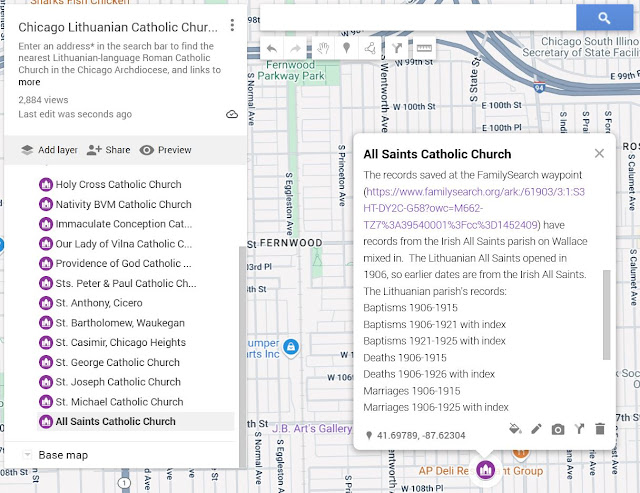This post is about finding obituaries in Draugas, the Chicago-area Lithuanian-language newspaper, which began publication in 1909 and is still going strong today. Here is a link to the page to search its archives:
This will take you to the page pictured below. The first link under "Paieška" lets you search the archive from 1909 through 2007, which is open to everyone.
When I click on that link, it brings up the following search page. In this example, I am looking for an obituary for
Juozapas (Joseph) Guokas, my second cousin thrice removed, who I already knew (from other sources) died April 22, 1938. I decided to start just by entering his surname in the search box.
There were only 13 results, and none of them were him. But the search mechanism for Draugas has an interesting fluke.
As mentioned on the initial search page, in Lithuanian, they don't know why, but when searching for a last name, the search finds a larger number of results when searching by last name together with the first name or first initial instead of presenting only the last name (e.g. J. Basanavičius instead of Basanavičius). So I decided to try that, searching for "Juozapas Guokas" (but without quotation marks), and sure enough, there was a link to him.
Before looking at the obituary itself, here's another way to search for them, but you'll need to know at least the year of death, and ideally the date of death or burial. Use the index - here is the link:
Here's what that page looks like. I clicked on the link for 1938.
On the page for each year, there's another search box, so I tried searching for Guokas again.
This time, it did bring up a single result, for my Juozapas Guokas.
However, before we look at the actual obituary, here's a way to look for an obituary that doesn't come up with a search. If you know the date of death, start checking issues on that date, out to about a week later. If you know the date of burial, start by checking the issue on that date (or the day after), and go backwards about a week. You can also check the whole month (and, if necessary, the first part of the next month) if you only know the month the death occurred.
Note that the newspaper isn't published every day. Also, note that sometimes there will be multiple copies of the same issue (indicated by various designations after the date, and usually because scans were provided from more than one source repository).
Juozapas Guokas died on April 21, but his obituary wasn't published until April 25. When you click on the link for that date, you get an image like the one below. Obituaries are almost always near the end of the issue, so I use the scroll bar on the right to slide to the last page and then scroll up, or you can enter the last page in the page counter at the top and jump to that. Or you can do a page search for your last name, or the first few letters of it. I found it's easiest to jump to the end and scroll up, because most obituaries have the same format.
And here is the
obituary for Juozapas Guokas, on the fifth of sixth pages for this issue. As you read more of these, you'll quickly learn key words and be able to pic out the names of relatives.
You can always highlight the text and copy it ...
... and then paste it into Google Translate, OCR errors and all, to get a rough translation.
Here's the important information, as far as I'm concerned, with my rough translations (in other words, what I've come to know these various words and abbreviations mean):
Juozapas Guokas died (mirė) April (Bal.) 21, 1938. He came from (kilo) Panevėžio district (apskr.), Smilgių parish (parap.), Valiliškių village (kaimo). He lived in (išgyveno) America 35 years (metus). He is survived by his wife (moterj) Petronėlė, maiden name (po tėvais) Šukiutė, son (sūnų) Peter (Petrą), daughter (dukterį) Stella (Stanislovą), two brothers (du brolius): Julius (Julijoną) and (ir) Stanley (Stanislovą) and his family (ir jo šeimą), sister (seserį) Domicėlę Žukauskienę and her family (ir jos šeimą), and many others.
The obituary goes on to name the funeral home (Anthony Petkus) and give information about the funeral. This one is on the 26th at St. Anthony parish church (
Šv. Antano par. bažnyčią) - that would be the one in Cicero, a Lithuanian parish. Almost all Lithuanian Catholics in the south part of Chicago were buried at St. Casimir Cemetery (
Šv. Kazimiero kapines), then almost entirely Lithuanian, and almost all were buried the same day as the funeral Mass.
As you can see, these obituaries are a goldmine of information!
© Amanda Pape - 2025 -
e-mail me!














































